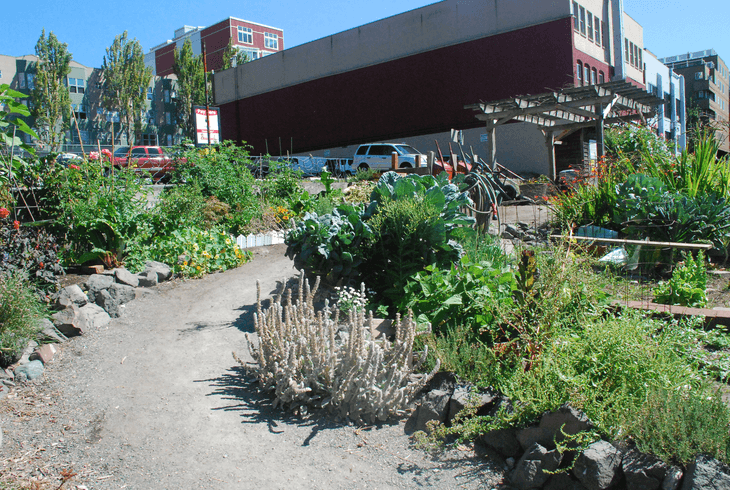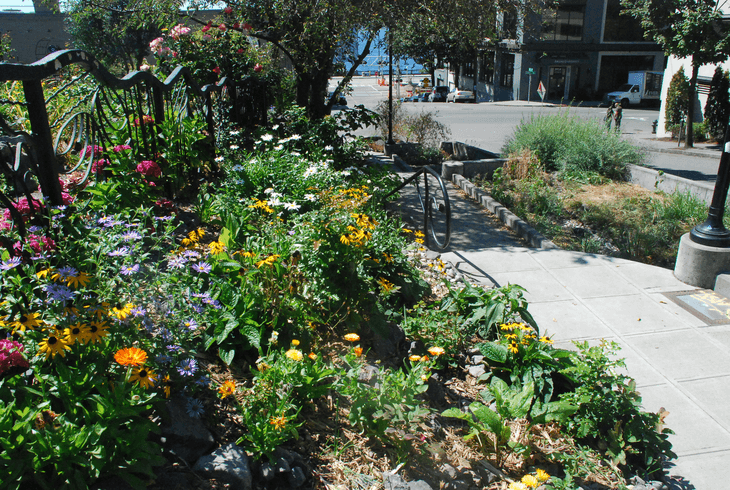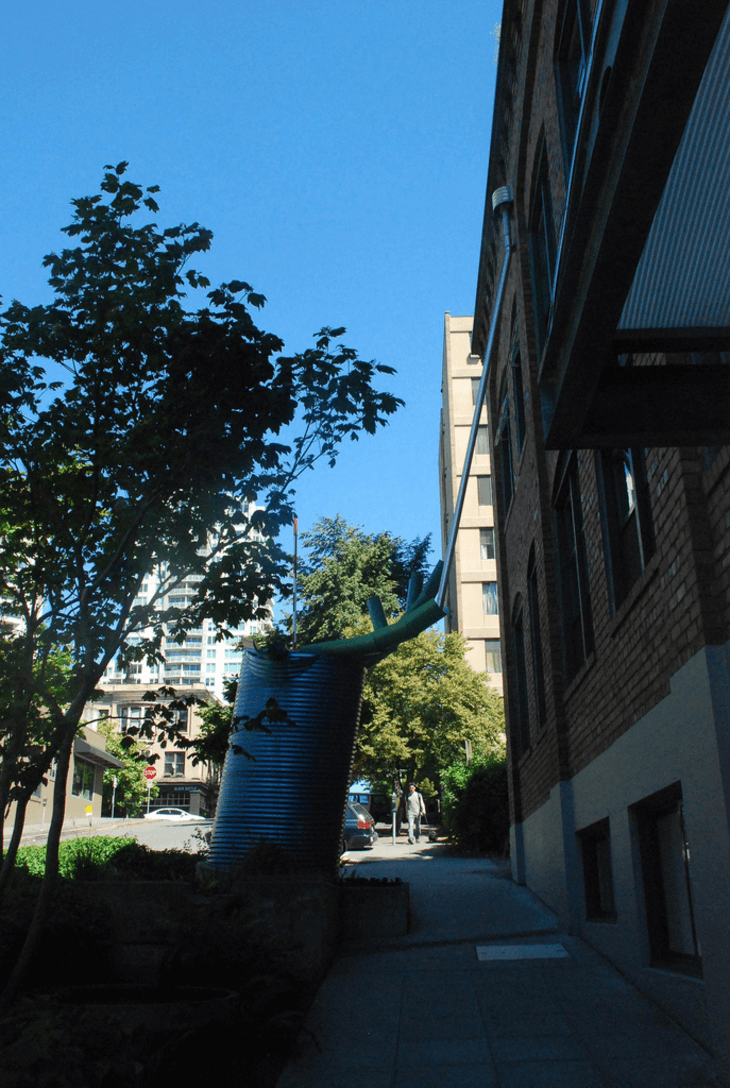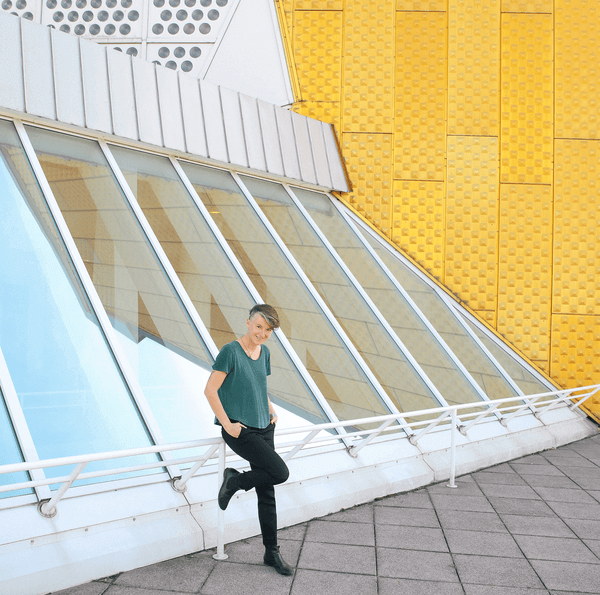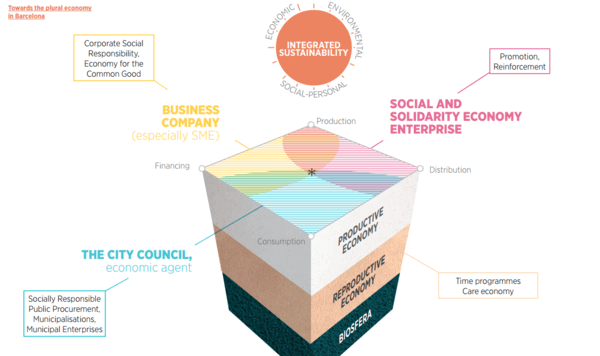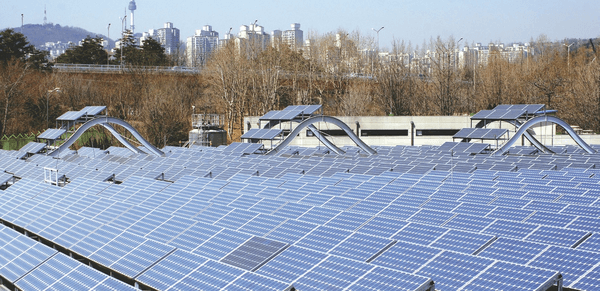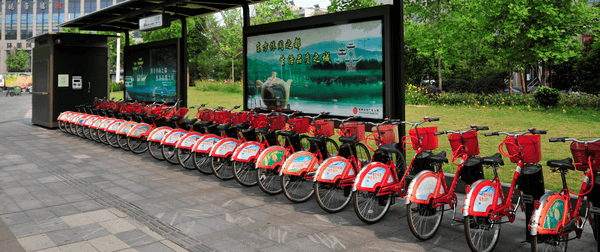Growing Vine Street
Status
completedCity
Seattle
Main actors
Local Government, Supranational / Intergovernmental Institutions, Private Sector, NGO / Philanthropy
Project area
Neighborhood or district
Duration
1995 - 2004
The Growing Vine Street project is a laboratory for green solutions within an urban design context and integrative governance approach.
The Growing Vine Street project turned the eight block length of Vine Street sloping to Elliot Bay into a laboratory for green solutions and integrative governance approach. The project aimed to collect and treat roof runoff through bio-filtration and use it for irrigating street plantings and community gardens, create a pedestrian friendly green space integrated with art, and reintroduce the natural hydrologic cycle into urban lives. Water is creatively channeled through downspouts, cisterns, terraced pools, and runnels. The project was built in stages as opportunities permitted with the goal to ease the burden on the city’s water treatment facilities through bio-filtration.
The early 90’s economic boom in Belltown saw parking lots and low rise commercial/industrial building replaced with high rise residential structures. Due to increased density, a diverse group of residents founded the initiative “Growing Vine Street.” The Seattle Neighborhood Planning program gave structure to the process. The Department of Neighborhoods Matching Grant program was one of many funding sources. At first the separate city departments were reluctant to build water gardens in the street, but through intense interaction over seven different city departments, King County, and several private developers became involved and supported this participatory and incremental project.
The neighborhood of Belltown, formerly known as Denny Regrade, was originally a hill which was regarded by sluicing it into Elliot Bay from 1897 - 1930 to make way for northerly expansion of the downtown core. Following the depression of the 30’s, steel construction enabled the construction of high rise buildings downtown, so the expansion never came. The area developed slowly into print shops, union halls, light manufacturing, low rent housing and parking lots. The comprehensive plan for Seattle identified the area for high rise residential to accommodate the cities growth and beginning in the early 90’s the population began to increase rapidly due to new construction and gentrification. The neighborhood lacked parks, green spaces, and public places for community interaction and identification.
A group of artists convinced the city to purchase a small piece of land for a community garden. This inspired the idea of expanding the green space of the garden into the street, and creating a green street connection from the waterfront through Belltown that would serve as a linear park for community interaction without costly property acquisition. The project aimed to create ecological benefits by bringing nature back into a concrete environment and social benefits by creating community spaces where people can work together to create and maintain the project. Water was included as an integral element to stimulate special life qualities in public to every citizen.
The main challenge was that the city had no process for approving a street design that was not tied to the construction of a project. The Growing Vine Street goal was to establish a design concept including handling of urban storm water and incorporating art so that the new developments along the street would build in conformance with the plan. The long term vision is to develop the project incrementally as part of new development or as funding becomes available to redevelop areas alongside existing buildings.
The Belltown P-Patch community garden opened in 1995 followed by an open house discussion about the possibilities of expanding the P-Patch into Vine Street which was previously designated a Green Street in the comprehensive plan. With no clear guidelines as to what a Green Street should be, the group began experimenting with ideas working with a Landscape Architecture class at University of Washington; the project grew to incorporate the 8 blocks length of Vine Street thereby giving birth to the Growing Vine Street Project.
In October 1996 the first annual fundraising event was held. In March 1997 King County and the City of Seattle provided the first grants to develop a conceptual basis. In April 1997 the Steering Committee wrote a mission statement during a three day charette at the University of Washington. Then, in July 1997 the Growing Vine Street Steering Committee set up project guidelines, and selected a design team consisting of architects, landscape architects, public artists, and consultants in the fields of sustainable design, transportation, and engineering. Opportunities for pedestrians were identified: e.g. connections to the city center, waterfront or surrounding markets, as well as principles like bringing the neighborhood into balance with ecological concerns. Design team and Steering Committee met frequently during this time and public meetings were organized for broader community input. In June 1998 a conceptual design document was prepared and presented to the city and community. Copies were printed and given to all city officials and departments and every property owner along Vine Street.
In February 1999 a half-day charrette was held at the Municipal Building with the design team, Steering Committee, and representatives from the Departments of Neighborhoods, Transportation, Public Utilities, Parks & Recreation, Strategic Planning, Construction & Land Use, members of the City Council, and the Port of Seattle. The goal was to determine how this multidisciplinary project could be permitted and funded. Regular meetings with pertinent city departments ensured that the plan could be approved without neglecting initial principles and objectives. Here, the major challenge was to maintain the process-oriented character as an “urban laboratory” and at the same time to find a detailed design for implementation.
Based upon these meetings and further negotiations with the city, the guideline book of implementation was published in March 2000 providing information about the design intent and possible methods of implementation. A central element in the plan was a runnel, which obtains its source by collecting roof runoff in cisterns on each block. Vine Street contains four zones: the entry portals on each end, a Flats zone, and a Slopes zone. One side of Vine Street in the Flats zone is narrow including a sidewalk and small planting strip while the other side is wide and allows the runnel to meander through greenery. Some angled parking is retained. The street-landscape of the Slopes zone is dominated by terraces allowing the water to step downhill.
The guideline book tried to clarify the responsibilities of public and private actors regarding the project’s implementation. Transportation developed a set of standards to create a pedestrian priority street for more design flexibility. The mayor, two members of the City Council, and the director of the Design Commission supported the project and would intercede for the community if the other departments attempted to change the initiative away from standard constructions.
At the same time the Belltown Neighborhood Plan consisting of three main strategies was developed. In the “Green Streets and Open Space Connections Strategy” the Growing Vine Street concept was a central element. By adopting the plan, the city was able to provide grant funds for areas applying key strategies for the project. Belltown received funding from the Department of Neighborhoods to construct the Cistern Steps, which were completed in October 2004. The Beckoning Cistern was already constructed in 2003 as a primarily privately funded project together with the Seattle Art Commission funding the artist for design and construction of the Cistern. While these two developments include rainwater runoff features, a third privately funded sub-development was constructed, which does not incorporate rainwater aspects.
The development was made possible through citizen engagement as well integrative governance strategies. Grants were given in the early stages by King County and the City of Seattle to develop a initial concept.
Other sections of the project were funded by complex arrangements. E.g. the Beckoning Cistern was mainly funded by a private developer. The City’s Office of Arts and Cultural Affairs funded the artist designing the work and took major responsibility for maintenance since it is officially a piece of public art. The Cistern Steps were mostly funded by the City’s Neighborhood Matching Fund as one of 5,000 community self-help-projects over the past 25 years. King County and private donations gave support through fundraising events. Private Developers agreed to provide storm water from their surrounding buildings and constructed the pipelines.
The Seattle community reacted with great enthusiasm and wide-ranging support for the activities on Vine Street. It is seen as one of Seattle’s most innovative solutions to creating creative urban green space and embracing the oceanic climate characteristics. The combination of public art and nature attracts many citizens to spend time in the linear park despite traffic. The trees, water, and pools provide a relaxing environment and improve urban biodiversity.
Growing Vine Street shows what can be achieved by coordination and collaboration in planning, funding, and implementation. The project contributed to a shift in Seattle’s neighborhood development policy and confirms the benefits of the self-help approach. It emphasizes the need of interdisciplinary and interdepartmental governmental actions. By the time the Growing Vine Street Project design was finished and two sections built out, the city had changed their entire approach to storm water and green street design. Many smaller, but similar projects are now being constructed.
Maintenance is an ongoing issue and the city is currently allocating more resources for general maintenance. The gardeners at the community garden abutting Vine Street have done much of the daily maintenance, but it has become too much for them. There is a community organization developed out of Growing Vine Street called Friends of Belltown Gardens. They work with the city to improve a maintenance plan.
As typical for bottom-up oriented projects it is critical to motivate volunteers to participate. Throughout the years, hundreds of citizens were involved in the process. People continually came and went making it hard to establish a core-group of participants.
It was difficult to find alternative ways of funding, which combine the interests of all the actors involved. Due to the many grants involved in the different portions of the project, it was a challenge to monitor and report on each grant while trying to acquire enough financial resources to finish the project.
The project created a general spirit in cooperating with the different city departments. Nevertheless, a defined process or an agency guiding the initiative from the public side would have smoothed over the processes. The city now has initiated design and construction of a four block street park on the nearby Bell Street. Many of the ideas developed on Vine Street are being incorporated. Administrations announced that they will provide maintenance support for Bell Street and indicated that they may increase their maintenance of Vine Street as a result of the new policy.
Experts of Seattle City Government who are active partners of the community identified three major lessons learned:
- The focus has to be on the whole neighborhood rather than limited functions and responsibilities in which public structures or other agencies are mainly organized. The project would never have been possible if each department was only concerned with their own priorities.
- Instead of exclusively emphasizing the needs of local communities, their strengths should be pointed out and fostered.
- Citizens’ initiatives should be given preference over driving a strict agenda.´
Continuity is essential when citizens are the main actors of a project. The participative process was long and partially problematic. During the project more than a hundred volunteers participated, and the active group constantly changed as people moved in and out. The commitment of individuals as driving motors of developments like Growing Vine Street should be pointed out. They provide the vision, community connections, and perseverance. They motivate others to participation, and should therefore be specially awarded.
The quality of the design work was exceptional and a huge contribution to the success of the project. Sculptor Buster Simpson’s Beckoning Cistern has become a noted art piece in the community. The ability to negotiate with the city to allow steps where there was a steep sidewalk made the gracious Cistern Steps possible.
The Seattle Design Commission is following through by requiring new construction on Vine Street to develop in keeping with the Growing Vine Street concept. In January of 2013 a new project began design. It is the missing link between the Cistern Steps and the Beckoning Cistern. Through the Design Review process the community is giving input into the design process and a successful outcome is anticipated.
Websites:
City of Seattle (2010): Demographics. On: http://www.cityofseattle.net/oir/datasheet/demographics.htm (12.12.2012)
Growing Vine Street (2004-2005): Website. On: www.growingvinestreet.org (22.12.2012)
Literature:
Diers, J. (2004):Neighbor Power: Building Community the Seattle Way. Seattle: University of Washington Press.
Geise, C.; Dunphy, K.; Ford, J.; Hogben, S. and Wadell, G. (2004): Growing Vine Street Revisited 2004. Download on: http://www.growingvinestreet.org/book.html (23.12.2012)

